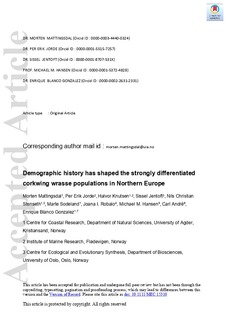| dc.contributor.author | Mattingsdal, Morten | |
| dc.contributor.author | Jorde, Per Erik | |
| dc.contributor.author | Knutsen, Halvor | |
| dc.contributor.author | Jentoft, Sissel | |
| dc.contributor.author | Stenseth, Nils Christian | |
| dc.contributor.author | Sodeland, Marte | |
| dc.contributor.author | Robalo, Joana I. | |
| dc.contributor.author | Hansen, Michael M. | |
| dc.contributor.author | André, Carl | |
| dc.contributor.author | Gonzalez, Enrique Blanco | |
| dc.date.accessioned | 2020-01-10T12:05:47Z | |
| dc.date.available | 2020-01-10T12:05:47Z | |
| dc.date.created | 2019-11-25T10:16:44Z | |
| dc.date.issued | 2019 | |
| dc.identifier.citation | Molecular Ecology. 2019, . | nb_NO |
| dc.identifier.issn | 0962-1083 | |
| dc.identifier.uri | http://hdl.handle.net/11250/2635690 | |
| dc.description.abstract | Understanding the biological processes involved in genetic differentiation and divergence between populations within species is a pivotal aim in evolutionary biology. One particular phenomenon that requires clarification is the maintenance of genetic barriers despite the high potential for gene flow in the marine environment. Such patterns have been attributed to limited dispersal or local adaptation, and to a lesser extent to the demographic history of the species. The corkwing wrasse (Symphodus melops) is an example of a marine fish species where regions of particular strong divergence are observed. One such genetic break occurred at a surprisingly small spatial scale (FST ~0.1), over a short coastline (<60 km) in the North Sea‐Skagerrak transition area in southwestern Norway. Here, we investigate the observed divergence and purported reproductive isolation using genome resequencing. Our results suggest that historical events during the post‐glacial recolonization route can explain the present population structure of the corkwing wrasse in the northeast Atlantic. While the divergence across the break is strong, we detected ongoing gene flow between populations over the break suggesting recent contact or negative selection against hybrids. Moreover, we found few outlier loci and no clear genomic regions potentially being under selection. We concluded that neutral processes and random genetic drift e.g., due to founder events during colonization have shaped the population structure in this species in Northern Europe. Our findings underline the need to take into account the demographic process in studies of divergence processes. | nb_NO |
| dc.language.iso | eng | nb_NO |
| dc.title | Demographic history has shaped the strongly differentiated corkwing wrasse populations in Northern Europe. | nb_NO |
| dc.type | Journal article | nb_NO |
| dc.type | Peer reviewed | nb_NO |
| dc.description.version | acceptedVersion | nb_NO |
| dc.source.pagenumber | 160-171 | nb_NO |
| dc.source.volume | 29 | nb_NO |
| dc.source.journal | Molecular Ecology | nb_NO |
| dc.source.issue | 1 | nb_NO |
| dc.identifier.doi | 10.1111/mec.15310 | |
| dc.identifier.cristin | 1751695 | |
| dc.relation.project | Norges forskningsråd: 280453 | nb_NO |
| dc.relation.project | Norges forskningsråd: 234328 | nb_NO |
| cristin.unitcode | 7431,23,0,0 | |
| cristin.unitname | Populasjonsgenetikk | |
| cristin.ispublished | true | |
| cristin.fulltext | postprint | |
| cristin.qualitycode | 2 | |
